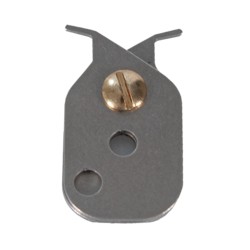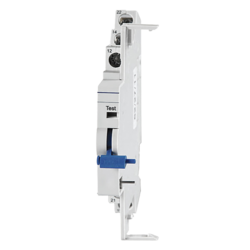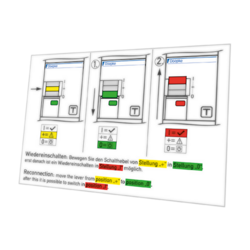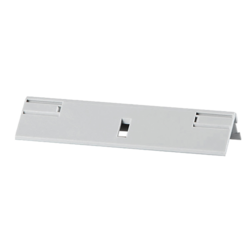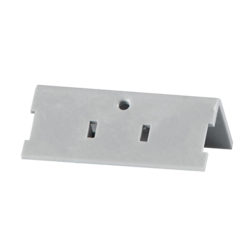residual current circuit-breaker DFS 4 016-4/0,03-B SK MI R
- AC-DC sensitive up to 150 kHz
- for mobile installations
- higher system availability: short-time delayed
- minimal power dissipation at each pole
- large connection terminals up to 50 mm²
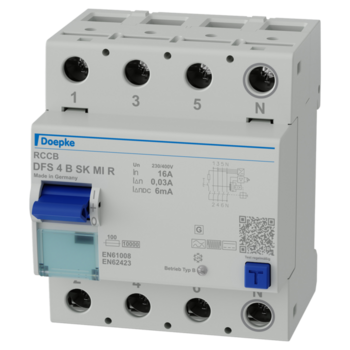

residual current circuit-breaker DFS 4 016-4/0,03-B SK MI R
- AC-DC sensitive up to 150 kHz
- for mobile installations
- higher system availability: short-time delayed
- minimal power dissipation at each pole
- large connection terminals up to 50 mm²
Details
Residual current circuit-breakers, four-pole, 16 A, 0,03 A, Type B SK, mobile installation, N right
Residual current circuit-breakers (RCCB) switch the power supply off if dangerous high residual currents occur. DFS 4 are two-terminal or two-terminal pair residual current circuit-breakers for single- or three-phase networks. In the standard design, the compact devices are just four module widths wide. They are available with many different residual current types and variants for rated currents up to 125 A. The large two-tier terminals can also accommodate large conductor cross-sections. The trip position of the multi-function toggle switch simplifies fault-finding. The free label software helps in the labelling process. Type B switches are AC-DC sensitive at frequencies of 0 Hz (smooth residual currents) to 150 kHz. They have increased resistance to surge currents and lightning. For residual current circuit-breakers with characteristic curve SK, the frequency response of the tripping current is designed so that residual currents with high frequencies, such as in the clock frequency range for frequency converters, as opposed to the rated frequency are detected with significantly reduced sensitivity. Undesired trips caused by leakage currents can therefore be widely avoided. However, fire protection depending on the rated residual current of the switch (0.03 A, 0.1 A or 0.3 A) is only provided for residual currents with frequencies up to 1 kHz, 300 Hz or 100 Hz, while the devices with tripping current frequency response B+ or NK offer protection over the entire tripping frequency range up to 20 kHz or 150 kHz, respectively. MI version AC-DC sensitive residual current circuit-breakers for mobile installation can easily be fitted downstream of Type A or unknown RCCBs. They are tripped at smooth DC residual currents of 6 mA and safeguard the protective function of upstream RCCBs.
High level of immunity against leakage and residual currents due to operational conditions from frequency 1 kHz and higher, AC/DC sensitive for residual currents with frequencies and mixed frequencies of 0 Hz (smooth direct current) up to 150 kHz, high availability even of voltage-independent detection of smooth DC residual current and AC residual current with frequencies not equal to 50/60 Hz thanks to full functional compatibility with mains voltages from at least 50 V AC on any two active conductors, mains-voltage-independent tripping when type A residual currents occur , compact design for all rated currents, high short-circuit resistance, double-sided two-tier terminals for large conductor cross-section and busbar, switch position indicator, viewing window for labels, multifunction switch toggle with three positions: "on", "off" and "tripped", Neutral conductor position right
quick fastening to mounting rail, any installation position, supply preferably from above
Ideally suited for mobile use in power distributors e.g. for rental equipment, where upstream RCCBs of an unknown type are present. Due to the low DC tripping threshold, the AC-DC sensitive RCCB version MI also can be operated downstream of an RCCB Type A or F, Commercial and industrial installations with TT, TN-S and TN-C-S systems, where power electronics equipment is used without galvanic isolation from the mains, e.g. frequency converters, switching power supplies, high-frequency converters, photovoltaic installations and UPS equipment with frequency converters without transformers.
suitable for use in 50 Hz AC networks, RCCBs for other frequencies available upon request, Not designed for use in direct current networks or on the output side of controlled electrical equipment such as frequency converters.
- Operating instructions
- Data sheet
- Prospectus Power for building sites
- Technical information Derating graph for DFS 2/4
- Prospectus Complete RCCB brochure
- Prospectus DFS 2 B/4 B
- Manual Manual RCDs Type B
- Technical information Tripping characteristics of DFS 4 Type B/B+
- Technical information dissipation power DFS 2/4
- Prospectus Circuit-breaker overview
- Prospectus DFS HD "heavy duty"
- Text for invitation to tender RTF
- Text for invitation to tender GAEB XML
- Text for invitation to tender GAEB 2000
- Text for invitation to tender GAEB 90
- Dimensional drawing Group view
- STEP file
- Wiring diagram
- Characteristic B SK 30 mA
- Labelling software DFS / DLS
- Download link Cadenas library
Residual current circuit-breakers, four-pole, 16 A, 0,03 A, Type B SK, mobile installation, N right
Residual current circuit-breakers (RCCB) switch the power supply off if dangerous high residual currents occur. DFS 4 are two-terminal or two-terminal pair residual current circuit-breakers for single- or three-phase networks. In the standard design, the compact devices are just four module widths wide. They are available with many different residual current types and variants for rated currents up to 125 A. The large two-tier terminals can also accommodate large conductor cross-sections. The trip position of the multi-function toggle switch simplifies fault-finding. The free label software helps in the labelling process. Type B switches are AC-DC sensitive at frequencies of 0 Hz (smooth residual currents) to 150 kHz. They have increased resistance to surge currents and lightning. For residual current circuit-breakers with characteristic curve SK, the frequency response of the tripping current is designed so that residual currents with high frequencies, such as in the clock frequency range for frequency converters, as opposed to the rated frequency are detected with significantly reduced sensitivity. Undesired trips caused by leakage currents can therefore be widely avoided. However, fire protection depending on the rated residual current of the switch (0.03 A, 0.1 A or 0.3 A) is only provided for residual currents with frequencies up to 1 kHz, 300 Hz or 100 Hz, while the devices with tripping current frequency response B+ or NK offer protection over the entire tripping frequency range up to 20 kHz or 150 kHz, respectively. MI version AC-DC sensitive residual current circuit-breakers for mobile installation can easily be fitted downstream of Type A or unknown RCCBs. They are tripped at smooth DC residual currents of 6 mA and safeguard the protective function of upstream RCCBs.
High level of immunity against leakage and residual currents due to operational conditions from frequency 1 kHz and higher, AC/DC sensitive for residual currents with frequencies and mixed frequencies of 0 Hz (smooth direct current) up to 150 kHz, high availability even of voltage-independent detection of smooth DC residual current and AC residual current with frequencies not equal to 50/60 Hz thanks to full functional compatibility with mains voltages from at least 50 V AC on any two active conductors, mains-voltage-independent tripping when type A residual currents occur , compact design for all rated currents, high short-circuit resistance, double-sided two-tier terminals for large conductor cross-section and busbar, switch position indicator, viewing window for labels, multifunction switch toggle with three positions: "on", "off" and "tripped", Neutral conductor position right
quick fastening to mounting rail, any installation position, supply preferably from above
Ideally suited for mobile use in power distributors e.g. for rental equipment, where upstream RCCBs of an unknown type are present. Due to the low DC tripping threshold, the AC-DC sensitive RCCB version MI also can be operated downstream of an RCCB Type A or F, Commercial and industrial installations with TT, TN-S and TN-C-S systems, where power electronics equipment is used without galvanic isolation from the mains, e.g. frequency converters, switching power supplies, high-frequency converters, photovoltaic installations and UPS equipment with frequency converters without transformers.
suitable for use in 50 Hz AC networks, RCCBs for other frequencies available upon request, Not designed for use in direct current networks or on the output side of controlled electrical equipment such as frequency converters.
- Operating instructions
- Data sheet
- Prospectus Power for building sites
- Technical information Derating graph for DFS 2/4
- Prospectus Complete RCCB brochure
- Prospectus DFS 2 B/4 B
- Manual Manual RCDs Type B
- Technical information Tripping characteristics of DFS 4 Type B/B+
- Technical information dissipation power DFS 2/4
- Prospectus Circuit-breaker overview
- Prospectus DFS HD "heavy duty"
- Text for invitation to tender RTF
- Text for invitation to tender GAEB XML
- Text for invitation to tender GAEB 2000
- Text for invitation to tender GAEB 90
- Dimensional drawing Group view
- STEP file
- Wiring diagram
- Characteristic B SK 30 mA
- Labelling software DFS / DLS
- Download link Cadenas library

